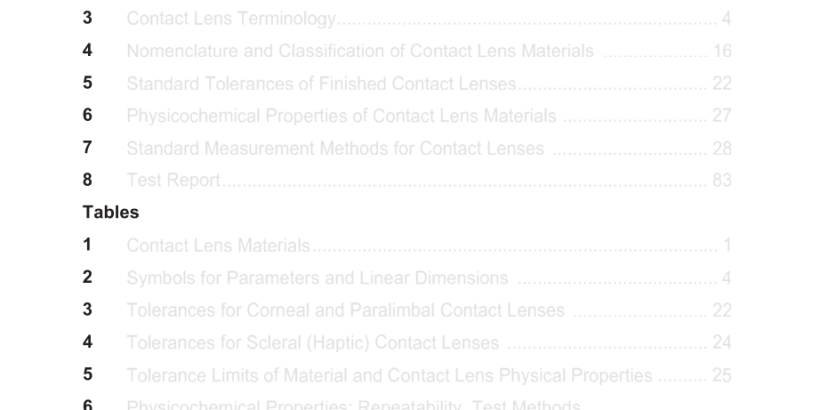ANSI Z80.20-2016 pdf download.Contact Lenses – Standard Terminology, Tolerances, Measurements and Physicochemical Properties
1.2 Purpose
The purpose of this standard is to incorporate tolerances for all contact lenses in a single standard and to provide, as much as possible, for standards in development by the International Standards Organization (ISO) for rigid and soft contact lenses. This standard is applicable for specifying (1) allowable tolerances; (2) measurement methods of parameters and properties important for proper functioning and manufacturing of contact lenses; and (3) conformance criteria for tested product. The standard includes tolerances for single-vision contact lenses, bifocal lenses, lenses that alter the optical density and/or spectral composition of transmitted visible light (tinted or pigmented contact lenses, such as those with enhancing, handling, and/or opaque tints), and lenses that significantly attenuate ultraviolet radiation (UVR-blocking lenses). This standard covers lenses designed with spherical, toric, and conoidally aspheric surfaces, and recommended methods for the specification of contact lenses.
2 Normative References
The following standards contain provisions which, through reference in this text, constitute provisions of this American National Standard. At the time of publication, the editions indicated were valid. All standards are subject to revision, and parties to agreements based on this American National Standard are encouraged to investigate the possibility of applying the most recent editions of the standards indicated below.
4.1.2 Stem
The stem identifies the material as hydrogel or non-hydrogel. Two established stems are used:“-focon” shall be affixed to the prefix of materials which have water contents less than 10%;“-filcon”shall be affixed to the prefix of materials with water contents greater than or equal to 10%.
4.1.3 Series Suffix
The series suffix is a capital letter used to distinguish an original polymer vs. subsequent modifications to the polymer where the ratio (but not type) or repeating monomers has changed. The capital letter“A” is the suffix for the original parent material, and subsequent polymers are designated by use of successive letters in the alphabet. The series suffix differentiates materials comprised of the same monomeric units though containing these units in different portions or ratios. The suffix is unnecessary when there is a single unique mixture of monomers.
4.2.1 Class Suffix
The lens material group is represented by a roman numeral. For“-filcon”materials, this numeral ranges from I to IV and indicates the hydrogel classification based on water content and ionicity (ionic content greater than 0.5 % mole fraction at pH 6 to 8) as defined in ISO 18369-1. [See Annex D, Bibliography.] Group V “filcon”materials represent a group of biphasic lens polymers containing both a hydrophilic phase and a hydrophobic polymer phase that have enhanced oxygen permeability (e.g., silicone hydrogels) greater than 40 Dk units (using mmHg) and a Dk greater than would be expected by water content alone. At this time group V polymers have been divided into three additional subgroups designated A-C defined by water content and iconicity (contains an ionic monomer or oligomer at pH 6 to 8). It is understood that the current data to describe the hydrophobic phase are not available and appropriate members based on the hydrophobic phase should be selected for use for testing based on risk assessment. For“-focon” materials, the Class Suffix also ranges from | to IV but indicates the non-hydrogel class based on generic chemical composition. Polymer formulations may also contain inhibitors, catalysts, color additives, absorbers of ultraviolet radiation, and fllers which may be present in the final material. For purposes of clarity and simplicity, these additives have been omitted from the stated composition.ANSI Z80.20-2016 pdf download
